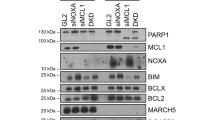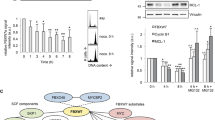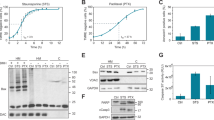Abstract
14-3-3 proteins are involved in several cellular processes, including the G1/S and G2/M cell cycle transitions. However, their roles during mitosis are not well understood. Here, we showed that depletion of 14-3-3η, a 14-3-3 protein isoform, enhanced mitotic cell death, resulting in sensitization to microtubule inhibitors and inhibition of aneuploidy formation. The enhanced mitotic cell death by depletion of 14-3-3η appeared to be both caspase-dependent and independent. Furthermore, enhanced mitotic cell death and a reduction in aneuploidy following 14-3-3η depletion were independent of the mitotic checkpoint, which is thought to be the primary signaling event in the regulation of the cell death induced by microtubule inhibitors. When 14-3-3η depletion was combined with microtubule inhibitors in HCT116 and U87MG cells, it sensitized both cancer cell lines to microtubule inhibitors. These results collectively suggest that 14-3-3η may be required for mitotic progression and may be considered as a novel anti-cancer strategy in combination with microtubule inhibitors.
This is a preview of subscription content, access via your institution
Access options
Subscribe to this journal
Receive 50 print issues and online access
$259.00 per year
only $5.18 per issue
Buy this article
- Purchase on Springer Link
- Instant access to full article PDF
Prices may be subject to local taxes which are calculated during checkout







Similar content being viewed by others
References
Aitken A . 14-3-3 proteins: a historic overview. Semin Cancer Biol 2006; 16: 162–172.
Hermeking H, Benzinger A . 14-3-3 proteins in cell cycle regulation. Semin Cancer Biol 2006; 16: 183–192.
Yaffe MB . How do 14-3-3 proteins work?-- Gatekeeper phosphorylation and the molecular anvil hypothesis. FEBS Lett 2002; 513: 53–57.
Saurin AT, Durgan J, Cameron AJ, . Faisal A, Marber MS, Parker PJ. The regulated assembly of a PKCepsilon complex controls the completion of cytokinesis. Nat Cell Biol 2008; 10: 891–901.
Wilker EW, van Vugt MA, Artim SA, Huang PH, Petersen CP, Reinhardt HC et al. 14-3-3sigma controls mitotic translation to facilitate cytokinesis. Nature 2007; 446: 329–332.
Meek SE, Lane WS, Piwnica-Worms H . Comprehensive proteomic analysis of interphase and mitotic 14-3-3-binding proteins. J Biol Chem 2004; 279: 32046–32054.
Nasmyth K, Peters JM, Uhlmann F . Splitting the chromosome: cutting the ties that bind sister chromatids. Science 2000; 288: 1379–1385.
Mollinedo F, Gajate C . Microtubules, microtubule-interfering agents and apoptosis. Apoptosis 2003; 8: 413–450.
Brito DA, Rieder CL . Mitotic checkpoint slippage in humans occurs via cyclin B destruction in the presence of an active checkpoint. Curr Biol 2006; 16: 1194–1200.
Dai W, Wang Q, Liu T, Swamy M, Fang Y, Xie S et al. Slippage of mitotic arrest and enhanced tumor development in mice with BubR1 haploinsufficiency. Cancer Res 2004; 64: 440–445.
Michel LS, Liberal V, Chatterjee A, Kirchwegger R, Pasche B, Gerald W et al. MAD2 haplo-insufficiency causes premature anaphase and chromosome instability in mammalian cells. Nature 2001; 409: 355–359.
Minn AJ, Boise LH, Thompson CB . Expression of Bcl-xL and loss of p53 can cooperate to overcome a cell cycle checkpoint induced by mitotic spindle damage. Genes Dev 1996; 10: 2621–2631.
Shin HJ, Baek KH, Jeon AH, Park MT, Lee SJ, Kang CM et al. Dual roles of human BubR1, a mitotic checkpoint kinase, in the monitoring of chromosomal instability. Cancer Cell 2003; 4: 483–497.
Taylor SS, McKeon F . Kinetochore localization of murine Bub1 is required for normal mitotic timing and checkpoint response to spindle damage. Cell 1997; 89: 727–735.
Weaver BA, Silk AD, Montagna C, Verdier-Pinard P, Cleveland DW . Aneuploidy acts both oncogenically and as a tumor suppressor. Cancer Cell 2007; 11: 25–36.
Castedo M, Perfettini JL, Roumier T, Andreau K, Medema R, Kroemer G . Cell death by mitotic catastrophe: a molecular definition. Oncogene 2004; 23: 2825–2837.
Murray AW . The genetics of cell cycle checkpoints. Curr Opin Genet Dev 1995; 5: 5–11.
Wassmann K, Benezra R . Mitotic checkpoints: from yeast to cancer. Curr Opin Genet Dev 2001; 11: 83–90.
Weaver BA, Cleveland DW . Decoding the links between mitosis, cancer, and chemotherapy: The mitotic checkpoint, adaptation, and cell death. Cancer Cell. 2005; 8: 7–12.
Nitta M, Kobayashi O, Honda S, Hirota T, Kuninaka S, Marumoto T et al. Spindle checkpoint function is required for mitotic catastrophe induced by DNA-damaging agents. Oncogene 2004; 23: 6548–6558.
Cregan SP, Dawson VL, Slack RS . Role of AIF in caspase-dependent and caspase-independent cell death. Oncogene 2004; 23: 2785–2796.
Nunez G, Benedict MA, Hu Y, Inohara N . Caspases: the proteases of the apoptotic pathway. Oncogene 1998; 17: 3237–3245.
Tsujimoto Y . Role of Bcl-2 family proteins in apoptosis: apoptosomes or mitochondria? Genes Cells 1998; 3: 697–707.
van Hemert MJ, Steensma HY, van Heusden GP . 14-3-3 proteins: key regulators of cell division, signalling and apoptosis. Bioessays 2001; 23: 936–946.
Chan TA, Hermeking H, Lengauer C, Kinzler KW, Vogelstein B . 14-3-3Sigma is required to prevent mitotic catastrophe after DNA damage. Nature 1999; 401: 616–620.
Didier C, Cavelier C, Quaranta M, Galcera MO, Demur C, Laurent G et al. G2/M checkpoint stringency is a key parameter in the sensitivity of AML cells to genotoxic stress. Oncogene 2008; 27: 3811–3820.
Niikura Y, Dixit A, Scott R, Perkins G, Kitagawa K . BUB1 mediation of caspase-independent mitotic death determines cell fate. J Cell Biol 2007; 178: 283–296.
Yang X, Cao W, Lin H, Zhang W, Lin W, Cao L et al. Isoform-specific expression of 14-3-3 proteins in human astrocytoma. J Neurol Sci 2009; 276: 54–59.
Stevens JB, Liu G, Bremer SW, Ye KJ, Xu W, Xu J et al. Mitotic cell death by chromosome fragmentation. Cancer Res. 2007; 67: 7686–7694.
Di Leonardo A, Khan SH, Linke SP, Greco V, Seidita G, Wahl GM . DNA rereplication in the presence of mitotic spindle inhibitors in human and mouse fibroblasts lacking either p53 or pRb function. Cancer Res 1997; 57: 1013–1019.
Lanni JS, Jacks T . Characterization of the p53-dependent postmitotic checkpoint following spindle disruption. Mol Cell Biol 1998; 18: 1055–1064.
Brunet A, Bonni A, Zigmond MJ, Lin MZ, Juo P, Hu LS et al. Akt promotes cell survival by phosphorylating and inhibiting a Forkhead transcription factor. Cell 1999; 96: 857–868.
Sunters A, Fernandez de Mattos S, Stahl M, Brosens JJ, Zoumpoulidou G, Saunders CA et al. FoxO3a transcriptional regulation of Bim controls apoptosis in paclitaxel-treated breast cancer cell lines. J Biol Chem 2003; 278: 49795–49805.
Liu Y, Ross JF, Bodine PV, Billiard J . Homodimerization of Ror2 tyrosine kinase receptor induces 14-3-3(beta) phosphorylation and promotes osteoblast differentiation and bone formation. Mol Endocrinol 2007; 21: 3050–3061.
Ha GH, Kim HS, Lee CG, Park HY, Kim EJ, Shin HJ et al. Mitotic catastrophe is the predominant response to histone acetyltransferase depletion. Cell Death Differ 2009; 16: 483–497.
Acknowledgements
We thank Ye Won Lee, Dr Jung Ki Kim, Min Young Kim and Min Su Ju for administrative support. This study was supported by National Research Foundation grant funded by the Korea government (MEST) (2011-0030833 and 2010-0007555), a grant from National R and D Program for Cancer Control, Ministry of Health and Welfare, Republic of Korea (0920290) and National R and D Program through the Dong-nam Institute of Radiological and Medical Sciences (DIRAMS) funded by the Ministry of Education, Science and Technology (50593-2011, 50594-2011 and 50597-2012).
Author information
Authors and Affiliations
Corresponding authors
Ethics declarations
Competing interests
The authors declare no conflict of interest.
Additional information
Supplementary Information accompanies the paper on the Oncogene website
Supplementary information
Rights and permissions
About this article
Cite this article
Lee, C., Park, GY., Han, Y. et al. Roles of 14-3-3η in mitotic progression and its potential use as a therapeutic target for cancers. Oncogene 32, 1560–1569 (2013). https://doi.org/10.1038/onc.2012.170
Received:
Revised:
Accepted:
Published:
Issue Date:
DOI: https://doi.org/10.1038/onc.2012.170
Keywords
This article is cited by
-
Circ_0000144 acts as a miR-1178-3p decoy to promote cell malignancy and angiogenesis by increasing YWHAH expression in papillary thyroid cancer
Journal of Otolaryngology - Head & Neck Surgery (2022)
-
Bub1 is required for maintaining cancer stem cells in breast cancer cell lines
Scientific Reports (2015)
-
14-3-3 eta depletion sensitizes glioblastoma cells to irradiation due to enhanced mitotic cell death
Cancer Gene Therapy (2014)
-
Evidence for the requirement of 14-3-3eta (YWHAH) in meiotic spindle assembly during mouse oocyte maturation
BMC Developmental Biology (2013)



